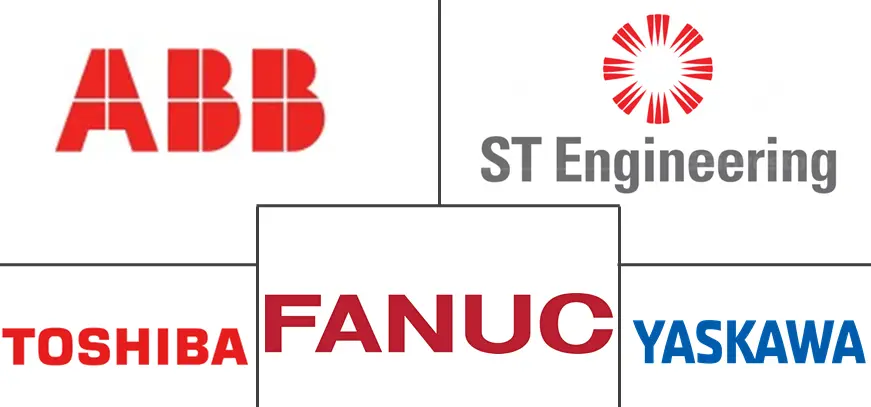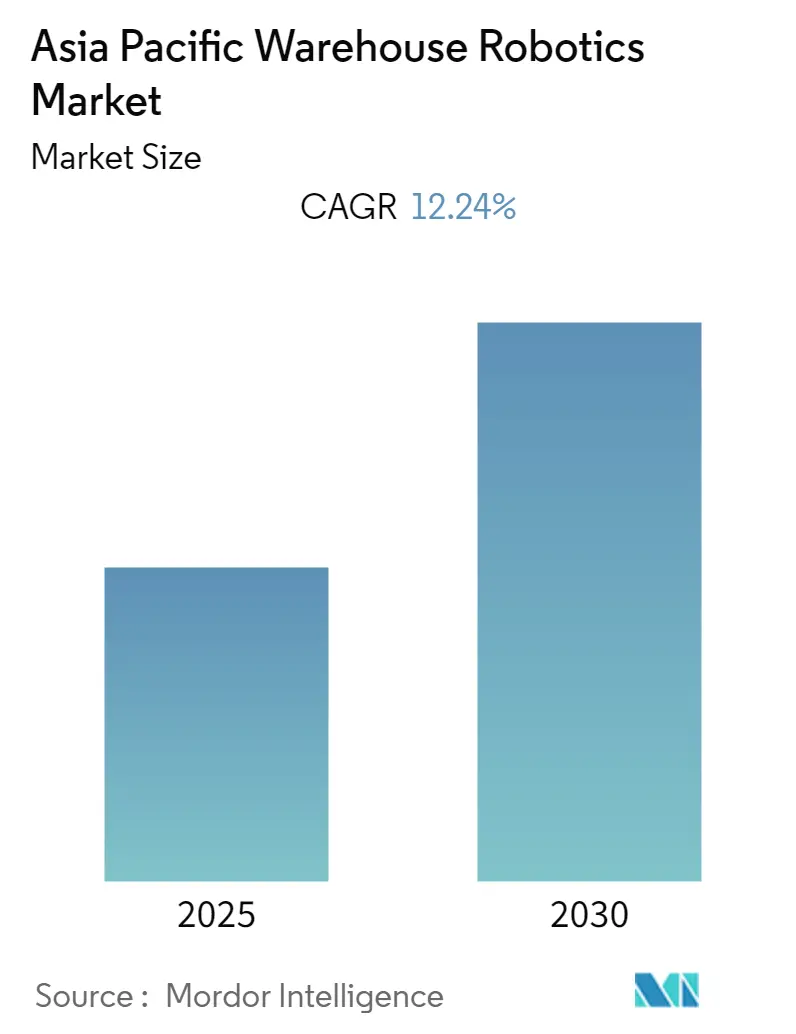
Asia Pacific Warehouse Robotics Market Analysis by Mordor Intelligence
The Asia Pacific Warehouse Robotics Market is expected to register a CAGR of 12.24% during the forecast period.
- Companies that already deployed these robots in their warehouses are witnessing the results during the pandemic. JD.com, a Chinese e-commerce giant based out of Wuhan, has been using a fleet of robotic vehicles in its automated warehouses to deliver essential goods to residents stuck at homes and shopping online. The company claims that it witnessed an increase in the daily orders from about 600,000 to nearly double in a single week during the pandemic.
- The South Korean government's measures ensure to boost the country's small and mid-size manufacturing companies, including the establishment of 30,000 smart factories by 2022. The government expects that small and mid-size firms in the manufacturing industry will create 66,000 jobs by automating 50% of their manufacturing facilities and increase KRW 18 trillion (USD 16 billion) of sales.
- Moreover, Japan has continuously maintained its position as the world's top exporter of robots in terms of the value of shipments and the number of operating units. For instance, Fuji Yusoki Kogyo Co. Ltd, Japan-based development and manufacturing of palletizing robots company, has sold over 16,000 robots all over the world. The company has a market share of 63% in the robotic palletizing industry of Japan and more than 20% market share in the world robotic palletizing industry.
- Amid the COVID-19 pandemic, companies in the country are rushing to deploy automation throughout the nation. Emil Hauch Jensen, VP of sales at Mobile Industrial Robots in Shanghai, stated that the company's autonomous robots that can move pallets and heavy loads across warehouses and factories witnessed increased demand across a wide range of industries. Many large players, such as Ford, Airbus, Flex, Honeywell, and DHL, are also responsible for the increasing demand.
Asia Pacific Warehouse Robotics Market Trends and Insights
Automated Storage and Retrieval Systems are Expected to Grow Significantly
- In China, automation is occurring at a rapid rate, despite the wage rate being lower (compared to European nations and North America, since there has been an increase in wage rate over the past decade), and this is expected to continue for the next decade.
- Moreover, with the 2020 Olympics scheduled to take place in Japan, the International Air Transport Association (IATA) called on the country to prepare its airport infrastructure. These factors are leading to an increased need for baggage picking, thus augmenting the market growth.
- South Korean government is planning to turn the nation’s robotics technology into a USD 13.3 billion industry, with the aim of becoming the fourth-largest player in the world by 2023. The Ministry of Trade, Industry, and Energy announced in March 2019 that it would finance the distribution of 7,560 manufacturing robots to replace human workforces in the areas of textiles, foods, and beverages that have been losing workers, due to hostile work environments and work intensity. ASR Systems are majorly used in huge warehouses for efficient storage and retrieval and are expected to grow in numbers as the rate of automation grows in the region.
- Japan has been among the early adopters of these solutions for its focus on efficiency improvement in the industry and across its supply chain. An increase in infrastructure investment by the government and investments from industries, along with the ‘Make in India’ initiative, are expected to drive the demand for AS/RS systems.
- Indonesia is categorized as an aggressive automation-adopting nation. The country has recorded increased robotic usage for industrial work. Since Japan is both its supplier and consumer, Indonesia is expected to benefit from the trade with Japan. Thus increasing the demand for automation in the region.
- Moreover, the increasing automation in the industrial sector and the growing demand for cost-effective material-handling systems are the two major driving factors for the global conveyor market. Growth in the automotive, retail, and food and beverage industries is also likely to fuel the growth of roller conveyer belts. Owing to the increasing need for roller-type conveyor systems, companies are trying to differentiate by providing more efficient systems. For instance, Interroll, in February 2019, presented new tapered elements for curved roller conveyors. The tapered elements, which offer optimized fixing, are currently being made available in Europe. The company also plans to launch these in the United States and Asia.
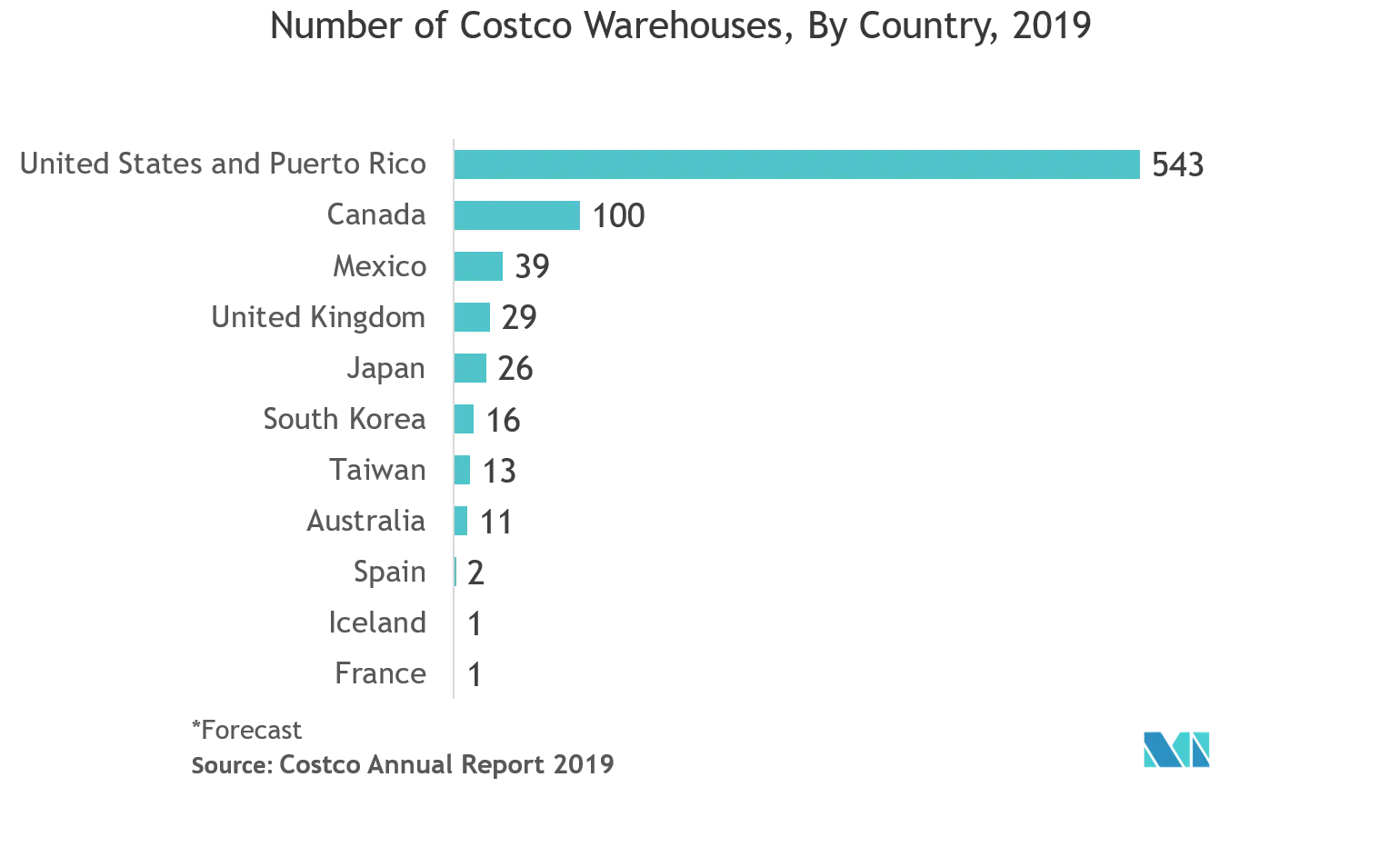
South Korea is Expected to Grow Significantly
- South Korea’s population is aging rapidly, and by the middle of this century, it will have one of the oldest populations out of all Organisation for Economic Co-operation and Development countries, just behind Japan, Italy, and Greece. Due to this, most of the manufacturing units are implementing industrial robots to maintain competitiveness.
- This also explains why South Korea has already embraced robots, particularly in its manufacturing sector, where “robot density” ranks second place in the world, following Singapore. With 774 industrial robots per 10,000 employees, the Republic of Korea has more than twice the number of Germany (3rd with 338 units) and Japan (4th with 327 units).
- The South Korean government’s measures ensure to boost the country’s small and mid-size manufacturing companies, including the establishment of 30,000 smart factories by 2022. The government expects that small and mid-size firms in the manufacturing industry will create 66,000 jobs by automating 50% of their manufacturing facilities and increase KRW 18 trillion (USD 16 billion) of sales.
- In addition, the government has supported the establishment of 7,800 smart factories until 2018 and has allocated KRW 1.21 trillion (USD 1.07 billion) to innovate small and mid-size smart manufacturing facilities in 2019. The Ministry of SMEs and Startups will first provide a total of KRW 2 trillion (USD 1.78 billion) in funds to be used in facility investments for smart factories. Policy lenders Korea Development Bank will provide KRW 1 trillion (USD 888.89 million), Industrial Bank of Korea KRW 500 billion (USD 444.45 million), and Small and Medium Business Corporation KRW 500 billion (USD 444.45 million).
- Owing to strong technological and mobile adoption, the country is one of the biggest e-commerce markets worldwide, with over 25 million e-shoppers in the country; South Korea stands third in GDP rankings. The vendors in the market are collaborating to develop robotic systems for the retail industry due to the rising demand for online services in the country.
- LG Electronics Inc. has partnered with a Korean retail outlet, E-mart Inc., that will result in the development of automated AI-driven shopping cart-like robots. The partnership encompasses nearly every aspect of development on the retail service robots with the goal of eliminating the need for any given shopper to push around a shopping cart.
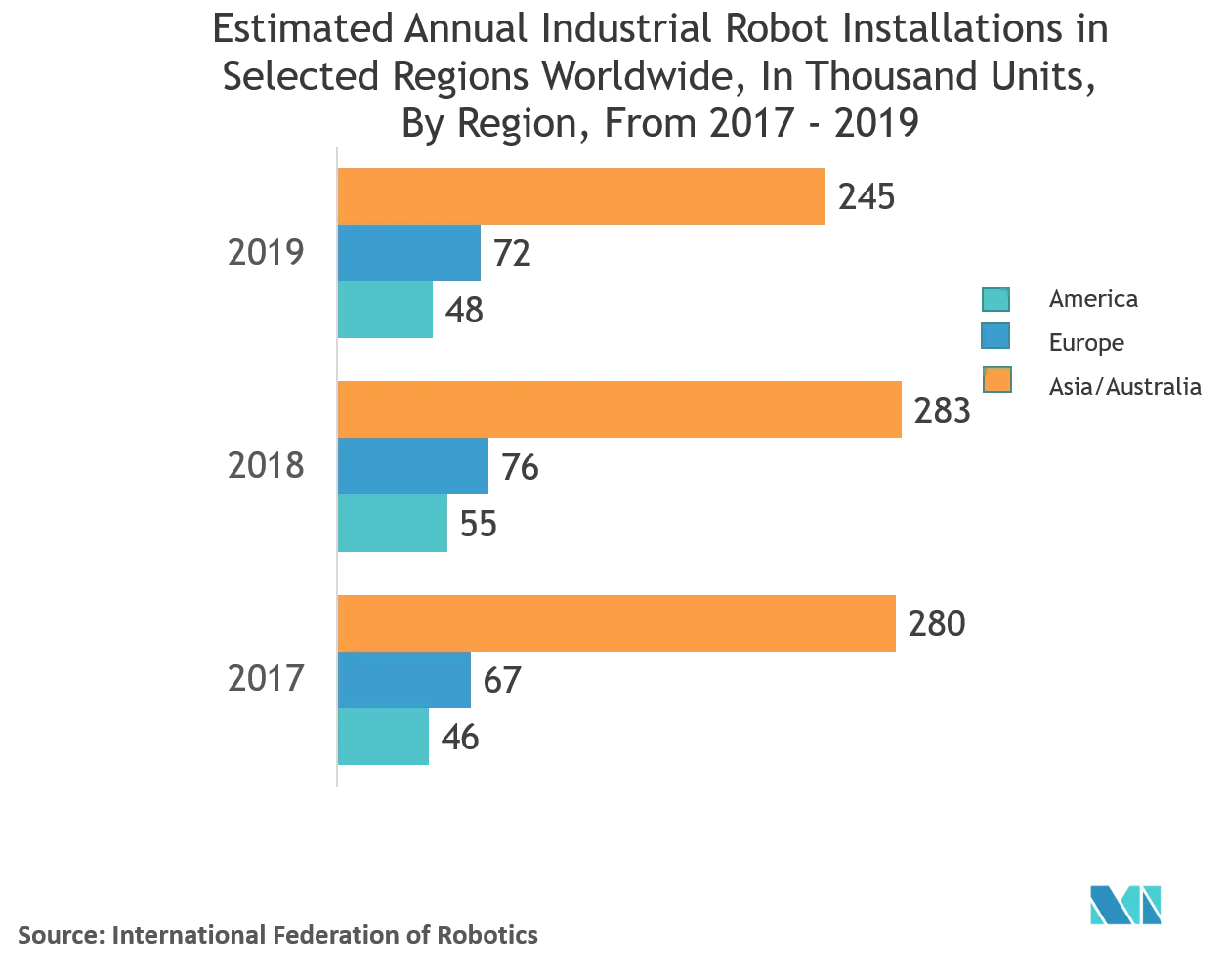
Competitive Landscape
The market for warehouse robotics is highly competitive. The degree of competition depends on various factors affecting the market, such as brand identity, powerful competitive strategy, and degree of transparency. The warehouse robotics market comprises of several global players, vying for attention in a fairly-contested market space. Some of the prominent players in the market include ABB, Fanuc, Yaskawa, Kuka, among others. The presence of these players and their constant innovative activities are intensifying the market scenario.
- April 2020 - Yaskawa Launched a new multipurpose robot, Motoman-GP300R, a new lineup of shelf-type robots that strengthens to save space in facilities. It operates downwards with a wide area where the footprint is mounted, which makes it ideal for handling work from above.
- January 2020 - Singapore Technologies Engineering partnered with Aidrivers for autonomous vehicles. The two companies signed a global partnership to collaborate on retrofitting prime movers with autonomous technology.
Asia Pacific Warehouse Robotics Industry Leaders
-
ABB Limited
-
Singapore technologies engineering ltd (aethon incorporation)
-
Fanuc Corporation
-
TOSHIBA CORP.
-
Yaskawa Motoman (Yaskawa Electric Corporation)
- *Disclaimer: Major Players sorted in no particular order
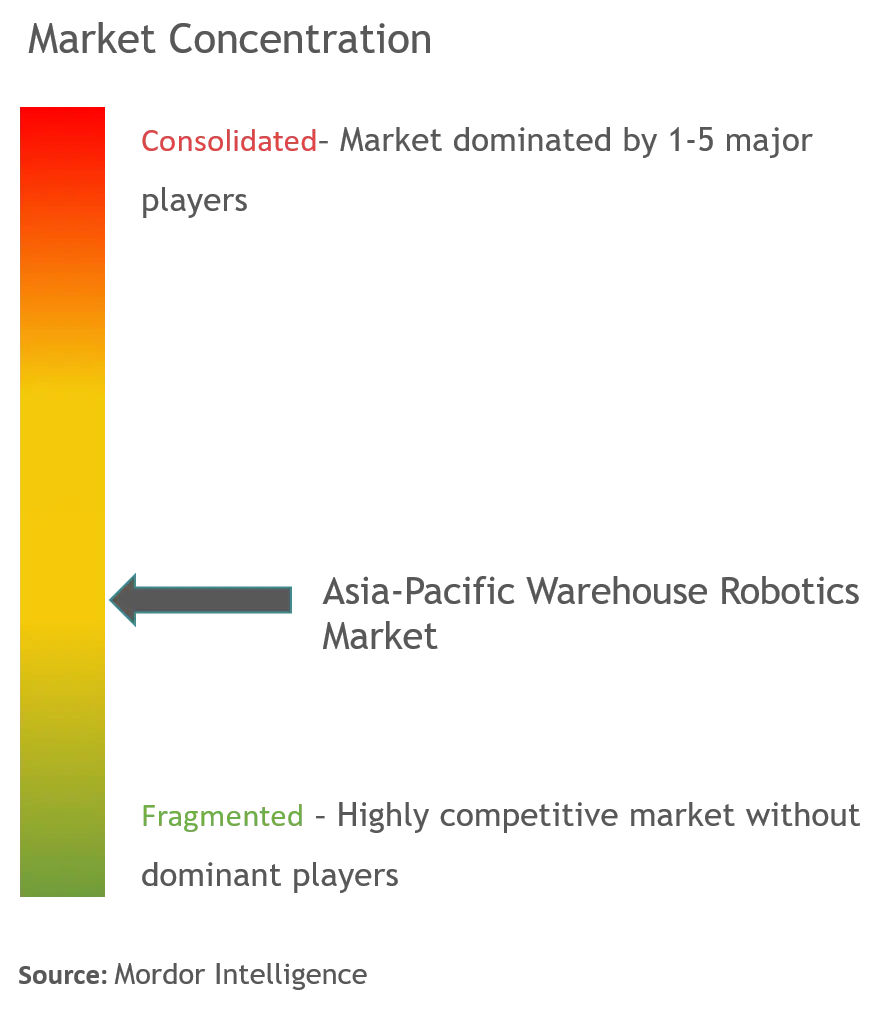
Asia Pacific Warehouse Robotics Market Report Scope
The warehouse is the most vital part of the supply chain process. They perform product transit that starts from the process of the production facility, acknowledgment, organizing, and also the tagging for delivering product on the required address. Warehouse robotics is the adoption of robotics in the warehouse that performs functions like Storage, Packaging, Trans-shipment, and Other Functions. End Users considered under the scope include Food and Beverage, Automotive, Retail, Electrical and Electronics, Pharmaceutical, and Other End Users. The study also provides the impact of COVID-19 on the market.
| Industrial Robots |
| Sortation Systems |
| Conveyors |
| Palletizers |
| Automated Storage and Retrieval System (ASRS) |
| Mobile Robots (AGVs and AMRs) |
| Storage |
| Packaging |
| Trans-shipments |
| Other Functions |
| Food and Beverage |
| Automotive |
| Retail |
| Electrical and Electronics |
| Pharmaceutical |
| Other End Users |
| China |
| Japan |
| South Korea |
| Rest of Asia-pacific |
| Type | Industrial Robots |
| Sortation Systems | |
| Conveyors | |
| Palletizers | |
| Automated Storage and Retrieval System (ASRS) | |
| Mobile Robots (AGVs and AMRs) | |
| Function | Storage |
| Packaging | |
| Trans-shipments | |
| Other Functions | |
| End User | Food and Beverage |
| Automotive | |
| Retail | |
| Electrical and Electronics | |
| Pharmaceutical | |
| Other End Users | |
| Country | China |
| Japan | |
| South Korea | |
| Rest of Asia-pacific |
Key Questions Answered in the Report
What is the current Asia Pacific Warehouse Robotics Market size?
The Asia Pacific Warehouse Robotics Market is projected to register a CAGR of 12.24% during the forecast period (2025-2030)
Who are the key players in Asia Pacific Warehouse Robotics Market?
ABB Limited, Singapore technologies engineering ltd (aethon incorporation), Fanuc Corporation, TOSHIBA CORP. and Yaskawa Motoman (Yaskawa Electric Corporation) are the major companies operating in the Asia Pacific Warehouse Robotics Market.
What years does this Asia Pacific Warehouse Robotics Market cover?
The report covers the Asia Pacific Warehouse Robotics Market historical market size for years: 2019, 2020, 2021, 2022, 2023 and 2024. The report also forecasts the Asia Pacific Warehouse Robotics Market size for years: 2025, 2026, 2027, 2028, 2029 and 2030.
Page last updated on:
Asia Pacific Warehouse Robotics Market Report
Statistics for the 2025 Asia Pacific Warehouse Robotics market share, size and revenue growth rate, created by Mordor Intelligence™ Industry Reports. Asia Pacific Warehouse Robotics analysis includes a market forecast outlook for 2025 to 2030 and historical overview. Get a sample of this industry analysis as a free report PDF download.
